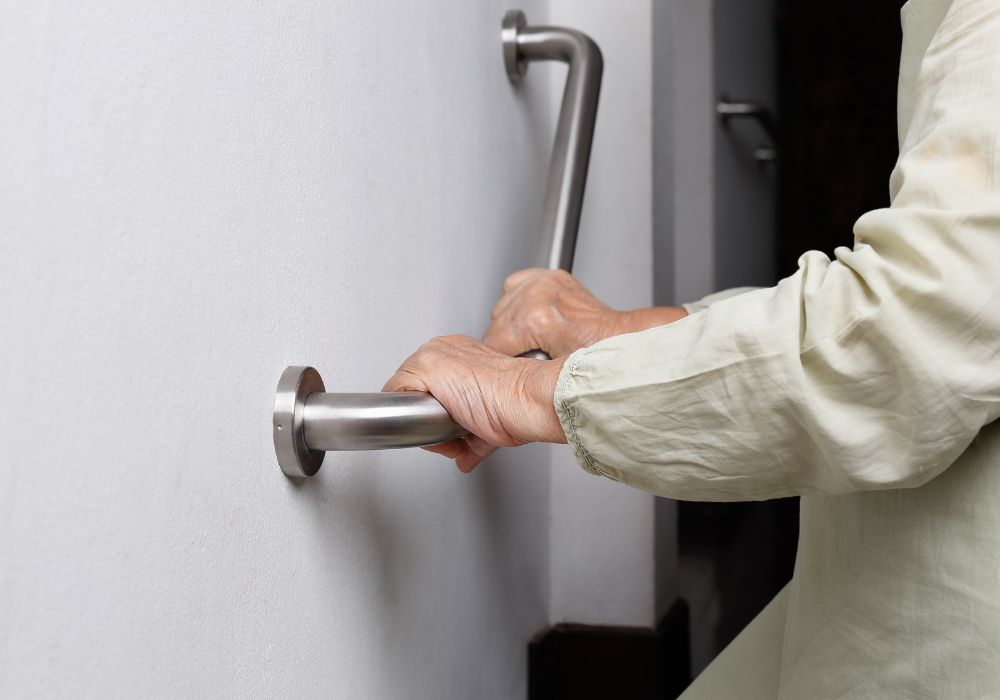
Key Takeaways
- Seniors with mobility challenges face increased risks of falls and injuries in their homes.
- Creating a safe and accessible home environment promotes independence and well-being.
- Key modifications include improving flooring, enhancing lighting, installing grab bars, and adapting doorways.
- Assistive devices such as walkers, reacher grabbers, and medical alert systems can support mobility and safety.
- Caregivers play a vital role in maintaining a safe home, assisting with daily tasks, and encouraging physical activity.
- Comfort Keepers Anchorage provides personalized in-home care to help seniors live safely and comfortably.
How Can You Make a Home Safer for Seniors with Mobility Issues?
You can make a home safer for seniors with mobility issues by removing tripping hazards, installing grab bars, improving lighting, widening doorways, and ensuring easy access to essential areas. Assistive devices and caregiver support can further enhance safety and independence.
Creating a Safe and Accessible Home for Seniors with Mobility Issues
As seniors age, mobility challenges can make daily tasks and activities more difficult, increasing the risk of falls and injuries. A home that once felt familiar and safe can become a source of obstacles if not properly adapted to their changing needs. Creating a comfortable and safe living environment for seniors with mobility issues is essential to maintaining their independence, confidence, and quality of life.
At Comfort Keepers Anchorage, we understand the importance of designing a senior-friendly home that prioritizes safety, accessibility, and comfort. In this comprehensive guide, we'll explore practical strategies and modifications to help create a supportive living space for seniors with mobility concerns. We'll cover the importance of a safe home environment, how to assess potential hazards, practical modifications for each area of the home, the role of assistive devices and caregivers, and the impact on emotional well-being.
The Importance of a Safe Home for Seniors with Mobility Issues
A home should be a place of comfort and security, but for seniors with mobility challenges, common household features can pose significant risks. Steps, uneven flooring, tight spaces, and poor lighting can all contribute to falls, injuries, and decreased confidence in moving around the house. According to the National Council on Aging, falls are the leading cause of fatal and non-fatal injuries among older adults, with one in four Americans aged 65+ falling each year.
By making thoughtful modifications, family members and caregivers can help seniors maintain their independence and reduce the likelihood of accidents. Ensuring a home is accessible and functional can also ease the burden on caregivers, making daily routines smoother and more manageable. A safe home environment not only prevents physical harm but also promotes emotional well-being by allowing seniors to age in place with dignity and autonomy.
Assessing the Home for Mobility Challenges
Before making changes, it's essential to assess the home environment for potential hazards. Walk through the home with a critical eye, considering the specific needs and abilities of the senior resident. Some key questions to ask during the assessment include:
- Tripping Hazards: Are there any loose rugs, cords, or uneven flooring that could cause a senior to trip and fall? Look for potential obstacles in high-traffic areas and consider removing or securing them.
- Space for Mobility Aids: Is there enough space for mobility aids like walkers or wheelchairs to maneuver easily? Measure doorways, hallways, and rooms to ensure they can accommodate the necessary equipment.
- Accessibility of Essential Items: Are frequently used items, such as clothing, toiletries, and kitchen supplies, within easy reach? Consider reorganizing storage spaces to make essentials more accessible and reduce the need for bending or reaching.
- Lighting Adequacy: Is the lighting sufficient in hallways, staircases, and common areas? Poor lighting can make it difficult for seniors to navigate their homes safely, increasing the risk of falls and accidents.
- Entrance and Exit Ease: Are the entrances and exits easy to access and navigate? Look for potential barriers, such as steps or narrow doorways, that may make it challenging for seniors to enter or leave their homes.
By identifying specific problem areas, families can prioritize modifications and create a targeted plan to improve home safety and accessibility.
Practical Modifications for a Safe and Comfortable Home
Making adjustments to the home doesn't always require major renovations. Many simple modifications can make a significant difference in safety and accessibility. Let's explore practical changes for each area of the home:
1. Improving Flooring and Pathways
Flooring should be smooth, even, and free of obstacles to reduce the risk of falls. Consider the following modifications:
- Remove or Secure Loose Rugs: Loose rugs are a common tripping hazard. Either remove them entirely or secure them firmly to the floor using non-slip backing or double-sided tape.
- Replace Slippery Surfaces: Slippery tile or hardwood floors can be treacherous for seniors with mobility issues. Consider replacing them with non-slip surfaces like textured vinyl, cork, or low-pile carpeting.
- Repair Uneven Flooring: Uneven flooring, such as raised thresholds or loose floorboards, can cause seniors to trip. Repair any unevenness or install threshold ramps for easier movement between rooms.
- Clear Clutter from Pathways: Ensure hallways and pathways are clear of clutter and furniture that may obstruct movement. Remove any unnecessary items and rearrange furniture to create wide, unobstructed paths.
2. Enhancing Lighting for Visibility
Good lighting is crucial for seniors with mobility issues, especially in areas with steps or narrow walkways. Consider these lighting improvements:
- Install Bright, Energy-Efficient Lighting: Replace dim or inadequate lighting with bright, energy-efficient LED bulbs. Focus on key areas like hallways, bathrooms, and entryways to ensure they are well-lit.
- Use Motion-Sensor Lights: Motion-sensor lights can automatically illuminate paths when a senior enters a room or hallway, reducing the need to fumble for light switches in the dark.
- Add Task Lighting: Install task lighting under cabinets, near reading areas, and in other commonly used spaces to provide focused illumination and reduce eye strain.
3. Modifying Entrances and Exits
Getting in and out of the home should be safe and simple for seniors with mobility challenges. Consider the following modifications:
- Install Ramps: If the home has steps leading to the entrance, consider installing a ramp to eliminate the need for climbing. Ensure the ramp has a gentle slope and is equipped with handrails for support.
- Widen Doorways: Doorways should be wide enough to accommodate walkers or wheelchairs. If necessary, consider widening doorways to at least 32 inches to allow for easy passage.
- Add Railings and Grab Bars: Install sturdy railings or grab bars at steps, porches, and other entry points to provide extra support and stability for seniors as they navigate in and out of the home.
4. Creating a Senior-Friendly Bathroom
Bathrooms can be particularly hazardous for seniors due to slippery surfaces and the need for frequent bending and reaching. Consider these bathroom safety modifications:
- Install Grab Bars: Place grab bars near the toilet, shower, and bathtub to provide support and prevent falls. Ensure they are securely anchored to the wall and can support the full weight of an adult.
- Use a Walk-In Shower: Replace a high-sided bathtub with a walk-in shower to reduce the need for stepping over high edges. Look for showers with a low threshold, slip-resistant flooring, and a built-in seat for added safety.
- Add a Shower Chair or Bench: Place a sturdy, water-resistant chair or bench in the shower to provide a stable seated for bathing. This can help seniors maintain balance and reduce the risk of slips and falls.
- Use Non-Slip Mats: Place non-slip mats or adhesive strips inside and outside the shower or tub to provide traction on wet surfaces. Choose mats with a strong grip and avoid those with a tendency to bunch up or slide.
- Consider a Raised Toilet Seat: A raised toilet seat with armrests can make it easier for seniors to sit down and stand up from the toilet. Look for models that securely attach to the toilet and provide a stable, comfortable seating surface.
5. Adapting the Kitchen for Accessibility
A well-organized and adapted kitchen can make meal preparation safer and more manageable for seniors with mobility issues. Consider these kitchen modifications:
- Store Items Within Reach: Rearrange cabinets and drawers so that frequently used items, such as dishes, utensils, and food, are stored within easy reach. Avoid placing essentials on high shelves or in low, hard-to-access spaces.
- Use Pull-Out Shelves and Lazy Susans: Install pull-out shelves and lazy Susans in cabinets to make it easier to access items without having to bend or reach. These modifications can also help maximize storage space and keep the kitchen organized.
- Replace Heavy Cookware: Swap heavy pots, pans, and other cookware with lightweight, ergonomic alternatives. Look for options with easy-grip handles and well-balanced designs to reduce strain on hands and wrists.
- Install Lever-Style Faucets: Replace traditional twist faucets with lever-style handles that are easier to operate with limited hand strength or dexterity. Consider motion-activated or touch-sensitive faucets for even greater ease of use.
6. Making the Bedroom Safe and Comfortable
A well-arranged bedroom promotes restful sleep and minimizes nighttime hazards for seniors with mobility challenges. Consider these bedroom safety modifications:
- Use an Adjustable Bed: An adjustable bed allows seniors to easily change the position of their head and feet, making it easier to get in and out of bed and find a comfortable sleeping position. Look for models with remote controls and easy-to-use adjustments.
- Install Bed Rails: Bed rails can provide support and stability when getting in and out of bed, reducing the risk of falls. Choose rails that are sturdy, securely attached to the bed frame, and easy to operate.
- Keep Essentials Close at Hand: Place a nightstand within easy reach of the bed to keep essentials like water, medication, a phone, and a lamp easily accessible. This reduces the need for seniors to get out of bed during the night.
- Install Motion-Activated Nightlights: Motion-activated nightlights can automatically illuminate the path to the bathroom or other areas of the bedroom when a senior gets up during the night, reducing the risk of falls in the dark.
7. Improving Stair Safety
If the home has stairs, extra precautions are necessary to prevent falls and ensure safe navigation. Consider these stair safety modifications:
- Install Handrails on Both Sides: Install sturdy handrails on both sides of the staircase to provide support and stability for seniors as they climb up and down. Ensure the handrails are securely anchored and extend beyond the top and bottom steps.
- Use Non-Slip Treads: Apply non-slip treads or adhesive strips to each step to provide better traction and reduce the risk of slips and falls. Look for treads with a strong grip and a visible contrast to the step color for added safety.
- Consider a Stairlift: If navigating stairs becomes too difficult or dangerous for a senior, consider installing a stairlift. These motorized chairs glide along a rail attached to the staircase, allowing seniors to safely and easily travel between floors.
Encouraging Independence with Assistive Devices
In addition to home modifications, using assistive devices can help seniors maintain independence while reducing the risk of falls and injuries. Some helpful assistive devices include:
- Walkers and Rollators: Walkers and rollators provide stability and support for seniors as they move around the house. Look for models with adjustable heights, ergonomic grips, and sturdy frames to ensure a safe and comfortable walking experience.
- Reacher Grabbers: Reacher grabbers are long-handled tools with a grasping claw on the end, allowing seniors to pick up objects from the floor or high shelves without bending or stretching. This can help prevent falls and strain on the back and joints.
- Voice-Controlled Devices: Smart home technology, such as voice-activated lights, thermostats, and appliances, can make daily tasks easier and more accessible for seniors with mobility issues. These devices can be controlled with simple voice commands, reducing the need for physical movement.
- Medical Alert Systems: Wearable medical alert devices allow seniors to call for help in case of a fall or other emergency. These systems typically include a button that can be pressed to alert a monitoring center or designated family members, providing added peace of mind and safety.
Supporting Emotional Well-Being in a Safe Home
A well-adapted home is not just about physical safety—it also plays a crucial role in supporting emotional well-being. A comfortable, familiar environment can foster confidence, reduce anxiety, and promote a sense of belonging. Consider these strategies for supporting emotional well-being in a safe home:
- Encourage Personalization: Allow seniors to personalize their living space with familiar decorations, family photos, and cherished possessions. This can help create a sense of comfort and familiarity, even as the home undergoes safety modifications.
- Create Relaxation Spaces: Designate cozy, inviting areas of the home for relaxation and enjoyment. This may include a comfortable reading nook with ample natural light, a peaceful outdoor seating area, or a space for engaging in hobbies and crafts.
- Promote Social Interaction: Ensure that common areas of the home, such as the living room and kitchen, are easily accessible and accommodating for social interaction. Encourage family and friends to visit regularly, and consider hosting small gatherings to keep seniors engaged and connected.
The Role of Caregivers in Maintaining a Safe Home
Caregivers and family members play an essential role in ensuring that home modifications remain effective and that the living environment continues to meet the changing needs of seniors with mobility issues. Some key responsibilities of caregivers include:
- Regular Safety Checks: Conduct regular inspections of the home to ensure that safety features, such as grab bars, handrails, and lighting, are in good working condition. Promptly address any necessary repairs or replacements to maintain a safe environment.
- Clutter Management: Keep pathways and common areas free of clutter and obstacles that could pose tripping hazards. Regularly declutter and organize the home to ensure easy navigation and accessibility.
- Monitoring Mobility Changes: Pay attention to changes in the senior's mobility, balance, or cognitive function that may require further home modifications or additional assistance. Work with healthcare professionals to assess evolving needs and adapt the home environment accordingly.
- Encouraging Physical Activity: Engage seniors in regular, gentle physical activity to maintain strength, flexibility, and overall mobility. This may include supervised walks, stretching routines, or exercises recommended by a physical therapist.
How Comfort Keepers Anchorage Can Help
At Comfort Keepers Anchorage, our compassionate caregivers are dedicated to helping seniors live safely and comfortably in their own homes. We offer a range of services to support home safety and independence, including:
- Assistance with Mobility: Our caregivers can provide hands-on assistance with walking, transferring, and other mobility tasks, reducing the risk of falls and injuries. We work with each senior to develop a personalized care plan that meets their specific needs and goals.
- Support with Household Tasks: Our team can assist with household organization, decluttering, and light housekeeping to maintain a safe and manageable living environment. We can also help with meal preparation, ensuring that seniors have access to nutritious, well-balanced meals.
- Personal Care and Companionship: Our caregivers provide compassionate, dignified assistance with personal care tasks such as bathing, dressing, and grooming. We also offer companionship and emotional support, engaging seniors in conversations, activities, and social interaction.
- Coordination with Healthcare Providers: We can work closely with healthcare professionals, such as physical therapists and occupational therapists, to ensure that home modifications and care plans are aligned with the senior's specific needs and goals.
Final Thoughts
Creating a safe and comfortable home for seniors with mobility issues is a vital step in supporting their independence, well-being, and quality of life. By assessing potential hazards, implementing practical modifications, and utilizing assistive devices, family members and caregivers can help seniors navigate their homes with confidence and ease.
At Comfort Keepers Anchorage, we understand the unique challenges and needs of seniors with mobility concerns. Our dedicated team of caregivers is committed to providing personalized, compassionate care that prioritizes safety, comfort, and dignity. We work closely with seniors and their families to develop individualized care plans that promote independence and enhance overall quality of life.
If you or a loved one could benefit from our in-home care services, we invite you to contact us today. Our knowledgeable team is here to answer your questions, provide guidance, and support you in creating a safe, nurturing home environment for your aging loved one. Together, we can help seniors with mobility issues thrive and enjoy the comfort of home with confidence and peace of mind.









